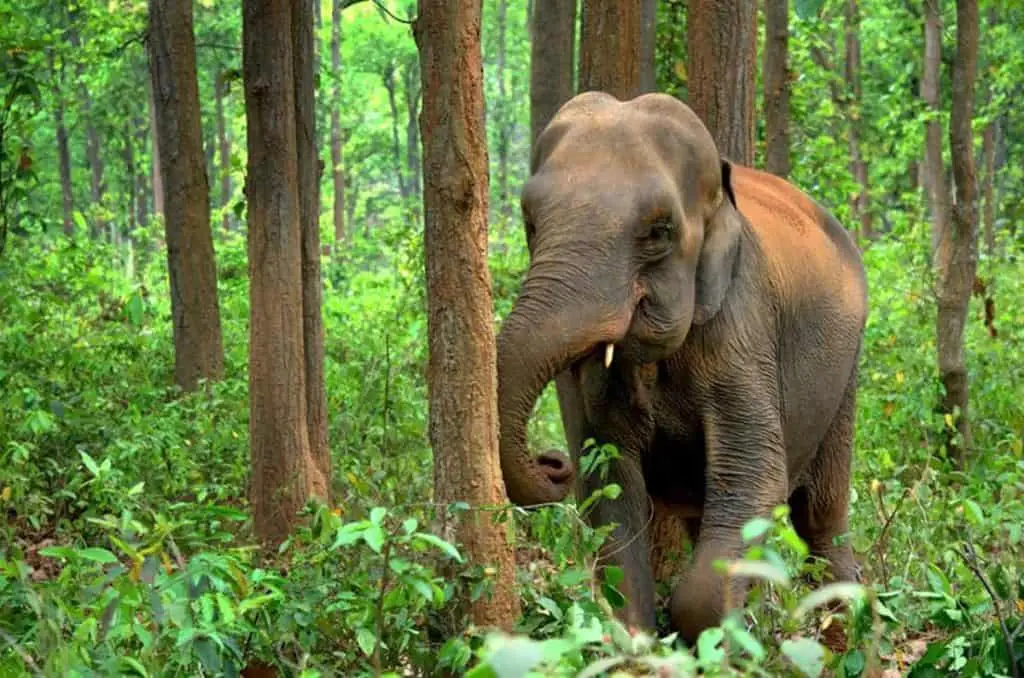Animals are a crucial part of the world’s biodiversity. They can be divided into two major groups: invertebrates and vertebrates. Invertebrates, such as insects and sponges, lack backbones while these defining characteristics define vertebrates like fish and mammals.
Understanding the differences between these two animal categories is important to appreciate their unique features and roles in our environment. This article will discuss the main distinctions between invertebrates and vertebrates by examining various anatomical, physiological, ecological, and evolutionary aspects.
The first key difference between invertebrates and vertebrates lies in their anatomy, most notably, whether or not they have a backbone. All animals without backbones belong to the phylum Arthropoda, which comprises over 85% of all known species on Earth today.
This group includes crustaceans like crabs and shrimps, mollusks such as snails and clams, spiders and scorpions from class Arachnida, and centipedes from Class Chilopoda, amongst many other kinds of creatures that share some common traits such as an exoskeleton for protection against dehydration.
On the other hand, members of the kingdom Animalia with backbones constitute around 15% of the total known species on planet earth, ranging from bony fishes to birds to reptiles up to mammals, including humans.
Vertebrate evolution has been marked by more complex organs than those found in invertebrates allowing them greater specialization for particular functions; this has enabled them to occupy diverse habitats, including air (birds), land (mammals), fresh water (fishes) or saltwater oceans(whales).
Moreover, unlike invertebrates, whose nervous system consists entirely of ganglia located at different body regions, vertebrate’s central nervous system is organized within a single tubular structure called the spinal cord which runs along its entire length providing sensory information about environmental conditions faster than what would be possible if it was localized across multiple parts of the body.

What Is An Invertebrate?
Invertebrates are animals that do not have a backbone or spinal column. They make up the largest group of animals on Earth, with over 95% of all animal species being invertebrates. Invertebrates include insects, spiders, crustaceans, mollusks, and worms.
Most invertebrate bodies are soft and often lack an internal skeleton. As such, they rely on their external exoskeletons to support muscle attachment points and protection from predators. Some invertebrates also possess segmented bodies, which give them flexibility and mobility, while others have specialized limbs like antennae or tentacles used for sensory input and interactions with the environment.
Though most vertebrate species have eyes that can detect light intensity changes and color differences in the environment, many invertebrates either lack eyes altogether or rely on simpler visual systems that are limited to detecting motion or shadows only.
Similarly, whereas some vertebrate senses, such as hearing, depend upon sound waves traveling through air to move vibrational energy into specialized organs within the body, most invertebrates must use other methods, including hairs around their bodies, to sense vibrations in their environments.
What Is A Vertebrate?
Vertebrates are animals that have a backbone or spinal column. They include mammals, birds, reptiles, amphibians, and fish. The vertebral column is made of small bones called vertebrae, which protect the spinal cord and support movement.
It also aids in posture and balance by transferring forces from one body part to another. Vertebrates have a specialized circulatory system with blood vessels that transport oxygen-rich blood throughout the body via their heart.
This circulatory system ensures the efficient delivery of nutrients and waste products within the organism’s body.
Vertebrates can move quickly due to muscular systems located along the length of their spine. These muscles allow them to flex their bodies in any direction, providing flexibility during locomotion.
Additionally, most vertebrate species possess lungs that assist in respiration, allowing them to take in air containing oxygen and expel carbon dioxide as a waste product. Furthermore, some species may develop complex organs such as eyes or ears. In contrast, others can generate more sophisticated sensory systems like smell or taste buds on certain body parts.
The presence of these characteristics has helped vertebrates become successful predators over time; this success has allowed them to be found in all habitats across the planet except for extreme environments such as deep sea trenches where there is no access to sunlight or food sources suitable for survival.
Despite being well adapted to living on land or water surfaces, several species might need further adaptations when facing new conditions, such as changing temperatures or salinity levels, to maintain viability outside their usual habitat range.
Population Of Vertebrates Vs. Invertebrates
Vertebrates and invertebrates are two broad categories of animals that have distinct traits that distinguish them from each other. Vertebrates, such as mammals, reptiles, and birds, possess a skeletal system with a spine or backbone, while invertebrates do not. This distinction is an important factor when considering the population of both vertebrate and invertebrate species.
Invertebrate species greatly outnumber vertebrate species due to their much greater diversity. Invertebrates range in size from microscopic organisms to huge creatures like jellyfish and octopuses; they are found on land and in aquatic environments worldwide.
The vast majority of animal life consists of various insects, arachnids, mollusks, crustaceans, sponges, worms, and more. These creatures represent up to 95% of the total animal species estimated by scientists today.
By contrast, there are only about 65000 known vertebrate species worldwide; this small fraction accounts for less than 5% of all existing animal life on Earth.
Mammals comprise roughly 4000 species, including humans; birds account for 9000; fish make up 28000; amphibians come in at 7000; and reptiles complete the list with 8000 species known. While fewer than the sheer variety present among invertebrates, vertebrates often play significant roles within their respective ecosystems as apex predators or keystone species thanks to their larger sizes and higher intelligence levels.
Considering these differentiating characteristics between vertebrates and invertebrates makes it clear why one group dominates over the other in terms of global population numbers.
Whereas invertebrates display myriad forms adapted for survival across diverse habitats around the world – which results in high biodiversity – vertebrates tend to be limited in comparison due to factors such as body structure complexity or specialized dietary requirements restricting their ability to colonize new areas successfully.
Evolution Of Invertebrates
The evolutionary history of invertebrates is an important topic in zoology study. Invertebrates comprise a vast and diverse group of animals, ranging from sponges to arthropods such as crabs or insects.
While all vertebrates are descended from ancestral fish-like organisms, the ancestry of invertebrates is more complex and poorly understood. Scientists have hypothesized that some early ancestors may have been small aquatic worms with simple nervous systems, while others believe they could have evolved from even simpler single-celled creatures.
To understand how these various groups evolved, scientists must utilize different research and analysis methods. Fossil records provide evidence of the evolution of certain species over time. Still, this data can be incomplete when examining ancient organisms for which there are no fossils or limited fossil records available.
Molecular biology studies offer another approach to understanding how different taxonomic groups developed through analyzing genetic sequences across multiple species within each group. This information can help us identify common characteristics between related species and piece together pathways by which new species emerge through natural selection processes.
Studies into the evolution of invertebrate species indicate that many modern phyla had begun diversifying at least 500 million years ago during the Cambrian period. However, their exact origin remains unclear due largely to gaps in our fossil record knowledge.
Nevertheless, it appears clear that most major animal species were present and thriving before the end of this period, leading some researchers to suggest that much earlier events likely led to their emergence 500 million years ago.
Evolution Of Vertebrates
Vertebrates are animals that have a backbone or spinal column. This contrasts invertebrates, which do not possess this skeletal structure.
The evolution of vertebrates has been studied extensively and can be divided into four major stages: the origin of chordates, from which all vertebrate life descended; the emergence of jawed fish during the Silurian period; the radiation of amphibians at the end of the Devonian period; and finally, the diversification of reptiles during the Carboniferous period.
The first stage began with the emergence of chordates about 540 million years ago. Chordates were primitive organisms characterized by stiffened rods known as ‘notochords’ running along their backs.
These organisms developed organs such as gills, eyes, hearts, and brains over time, gradually becoming more complex creatures capable of living on land and water. During the Silurian period (444-416 Mya), jawed fish appeared and rapidly became dominant among aquatic species, while colonies formed amongst arthropods on dry land.
The Devonian period (416-359 Mya) saw an increase in diversity among terrestrial and aquatic fauna, with lobe-finned fishes developing lungs and transitioning onto land to become what we now know as amphibians.
Reptiles emerged late in the Carboniferous period (359-299 Mya). These early reptiles adapted quickly to their environment, with some even evolving wings enabling them to fly like modern birds today. Evolutionary biologists believe that these adaptations allowed for reptilian dominance through much of prehistory until being replaced by mammals around 65 million years ago.

Main Difference – Vertebrates Vs. Invertebrates
Vertebrates and invertebrates are two distinct groups of animals that vary in many different ways. Vertebrates have a backbone, while invertebrates do not. This is the most obvious difference between the two kinds of animals, but several other differences exist.
Vertebrates have an internal skeleton composed of bone or cartilage. Additionally, they have muscles that attach to their bones and give them mobility. They also possess a spinal cord surrounded by vertebrae, with nerves extending outwards from this central nervous system throughout their bodies.
On the other hand, invertebrates do not have any skeleton; instead, most species rely on external structures for support, such as shells or jointed appendages like those found in arthropods. They lack a centralized nervous system and instead use bundles of nerve cells called ganglia located around their body for communication and coordination.
In addition to physical traits, both vertebrate and invertebrate animals differ greatly regarding behavior and habitat preferences. Vertebrates tend to be more active than invertebrates since they possess skeletal systems that allow them greater mobility than their counterparts.
Most species inhabit land environments; however, some live mainly in water habitats, such as fish or amphibians; meanwhile, invertebrates occupy almost every territory imaginable due to their adaptability – including air!
All these characteristics make it clear that these two animal groups evolved separately over time despite sharing common ancestors millions of years ago.
Although some overlap exists between the two groups when looking at specific individual species, overall, each group possesses unique adaptations that set them apart from one another, making them distinct entities within the animal kingdom today and providing evidence for the immense diversity of life on earth.
10 Differences Between Vertebrates And Invertebrates
The comparison between vertebrates and invertebrates is interesting, with many distinctions to be made. Invertebrates are animals that do not have a backbone or spinal column, while vertebrates possess such features. This article will explore ten differences between the two groups of organisms to provide greater insight into their respective characteristics.
To begin with, there is a considerable difference in terms of size. Most vertebrate species range between 10mm and 10m in length; however, some invertebrate species can exceed this size by far. Secondly, anatomical complexity also varies greatly between these two animal classes: most vertebrates feature bilateral symmetry, whereas invertebrates often display radial symmetry.
Additionally, the circulatory system within each type differs considerably – for example, vertebrates typically contain closed circulatory systems where blood remains internal throughout their bodies. Still, invertebrates may use open circulatory systems instead.
Furthermore, respiratory organs vary significantly across both categories, too – for instance, some species of fish rely on gills as an effective respiration organ, yet arthropods prefer tracheal tubes or spiracles instead.
Also noteworthy is the dramatic contrast in nervous system structures: while vertebrae boast centralized brains and complex networks of neurons spread throughout their body, many invertebrate counterparts only consist of nerve cords running down from the brain stem along with ganglia located at various points in the body.
Finally, another stark distinction between these two types of creatures lies in reproduction patterns: nearly all invertebrates reproduce through sexual means, but certain forms of amphibians have been known to produce via parthenogenesis (the development of an embryo without fertilization).
In summary, several major differences exist between vertebrates and invertebrates – ranging from structural anatomy to reproductive methods – making them distinct enough that they cannot easily be compared directly against one another.
Which Animals Are Vertebrates
Vertebrates are animals that have a backbone, which is also known as an internal skeleton. This feature separates them from invertebrates, which do not possess any internal skeletal structure. Vertebrates can be divided into five classes: fishes, amphibians, reptiles, birds, and mammals. Each class contains various species with unique characteristics, such as feathers in the case of birds or scales in fish.
In terms of physical features, vertebrate bodies are generally composed of two parts: head and trunk. The head typically includes sensory organs like eyes and ears, while the trunk houses most of its organs, including the heart, lungs, and digestive systems.
Additionally, most vertebrates exhibit four common limb types used for locomotion; fins in aquatic species like fish, legs in terrestrial animals like frogs and lizards, and wings for flight-capable creatures such as birds or bats.
Given these distinguishing traits, it becomes easier to identify potential vertebrates when observing wildlife around us. Common examples include cats and dogs among mammals or roosters among birds. However, within each class, numerous subclasses exist based on size, habitat preferences, or diet type, making identification slightly more challenging but possible with appropriate knowledge about individual species.

Which Animals Are Invertebrates
Invertebrates lack a vertebral column, also known as a backbone. These animals are typically characterized by their soft bodies and segmented appendages, such as legs or antennae. Invertebrates make up the majority of animal species on earth, with over 95% of all living creatures belonging to this group. Examples of invertebrate species include insects, mollusks, spiders, annelids, crustaceans, and jellyfish.
Unlike vertebrates, many invertebrates can regrow lost body parts or undergo regeneration. Additionally, some have remarkable abilities for camouflage or mimicry to avoid predators or find food sources. Many invertebrate species play an important role in maintaining ecosystems through pollination or providing nutrients from decaying matter back into the soil.
There is great diversity among invertebrate species, and they inhabit nearly every environment on Earth, from damp forests to hot deserts and salty ocean depths.
Several marine invertebrate groups provide commercial fisheries worldwide with key seafood products like clams and shrimp for human consumption. Furthermore, those same organisms may be used in medical research due to similarities between humans and other life forms at the cellular level, which provides valuable insights into biological processes related to human health and can lead to the development of new treatments and therapies.
Conclusion
In conclusion, the main difference between vertebrates and invertebrates is that vertebrates have a backbone or spinal column to support their body, whereas invertebrates do not. The evolution of vertebrates has been longer than invertebrates, resulting in more species having evolved from the former.
There are ten differences between these two phyla; for example, vertebrates have red blood cells with hemoglobin, while invertebrates don’t. Invertebrates include animals such as jellyfish and starfish, while some examples of vertebrates are mammals, reptiles, and birds.
It is clear that although both groups developed millions of years ago, they differ significantly in various aspects. Despite this, they still share characteristics like bilateral symmetry, which can be seen in both organisms.
Furthermore, it is notable that there are many more species of vertebrates than invertebrates on earth today due to their long evolutionary history.
Overall, understanding the distinction between these two species is important because it helps us to appreciate how complex life forms on Earth have evolved. It also serves as an essential foundation for further animal classification and evolution research.

